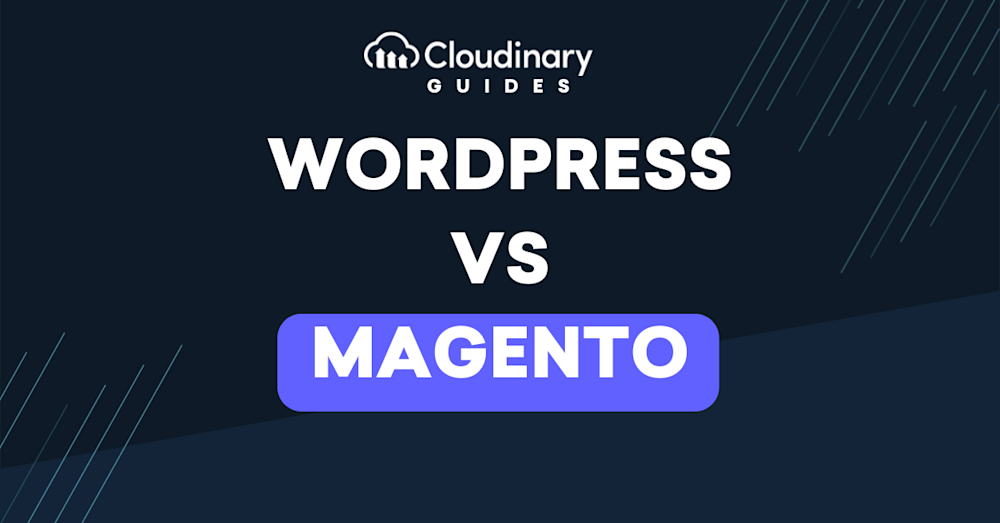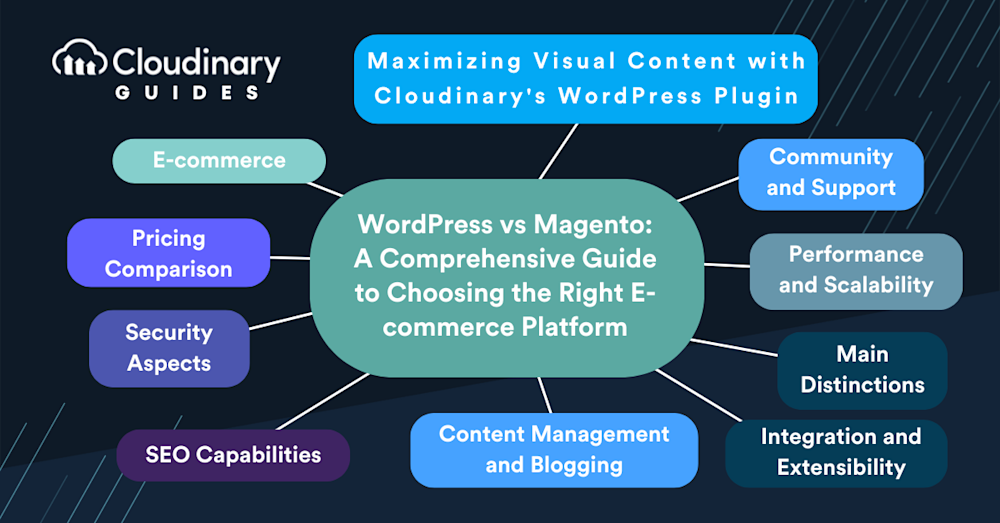Is Magento like WordPress? It’s crucial to pick an e-commerce platform that meets your current needs and supports your future growth. WordPress, its WooCommerce plugin, and Magento are two of the most common options. Both platforms offer robust features but are designed for different types of users and business needs.
WordPress is a content management system (CMS) with an extensive plugin ecosystem that serves multiple purposes. WooCommerce, a popular WordPress plugin that boasts an impressive 37% market share in 2023, transforms any WordPress site into a fully functional e-commerce store. Its ease of use and flexibility make it an excellent choice for small to medium-sized businesses and individuals looking for a straightforward way to start selling online.
Magento, on the other hand, is designed specifically for e-commerce. It’s a platform built with the complexity and demands of online stores in mind, offering extensive customization options, robust security features, and the ability to handle a large volume of products and transactions. Magento is best suited for medium to large businesses that require high scalability and customization.
In this article:
- WordPress vs Magento for E-commerce
- Pricing Comparison: WordPress vs. Magento
- Security: WordPress vs Magento
- SEO Capabilities: WordPress vs Magento
- Content Management and Blogging
- Integration and Extensibility
- Performance and Scalability
- Community and Support
- The Main Distinctions between WordPress and Magento
- Maximizing Visual Content with Cloudinary’s WordPress Plugin
WordPress vs Magento for E-commerce
WordPress (with WooCommerce) and Magento suitability depends on your project’s scale and complexity. WordPress is simple and user-friendly. Setting up a store is straightforward, making it ideal for those with limited technical skills or resources. Its plugin architecture allows for easy addition of features and integrations, although this can sometimes lead to a reliance on multiple plugins for essential e-commerce functionalities.
With its e-commerce-first approach, Magento provides a wide range of out-of-the-box features that cover the needs of larger online stores. It offers more advanced inventory management, multiple storefronts, and greater customization capabilities. However, this comes at the cost of a more demanding learning curve and potentially higher development costs, as making the most of Magento’s capabilities often requires professional assistance.
Pricing Comparison: WordPress vs. Magento
Pricing is a critical factor in choosing an e-commerce platform. WordPress, as an open-source platform, is free to use. However, running an e-commerce site on WordPress typically involves additional costs, including hosting, domain registration, themes, and plugins, including WooCommerce. While many plugins are free, premium options can add up, especially if you aim for advanced features or integrations.
Magento offers two main editions: Magento Open Source and Magento Commerce. The Open Source edition is free and caters to businesses looking to leverage community support and self-manage their store’s development. Magento Commerce, however, is a premium version that includes additional features, support, and cloud hosting options aimed at larger businesses with more complex needs. The cost of Magento Commerce can be significant, often requiring a considerable budget for both the platform and the necessary development work.
Security: WordPress vs Magento
Security is vital in e-commerce, as you deal with sensitive customer information and financial transactions. WordPress, the most popular CMS in the world, is a frequent target for malicious attackers. However, regular updates and a wide range of security plugins can help mitigate these risks. It’s crucial to keep your WordPress site, including all plugins and themes, up to date to protect against vulnerabilities.
Magento is known for its strong focus on security, offering dedicated security patches and updates. Its architecture is designed to provide robust protection for e-commerce operations. However, maintaining a Magento site’s security requires applying updates and understanding the platform. Magento’s proactive approach to security, including regular patches and updates, protects e-commerce sites.
SEO Capabilities: WordPress vs Magento
Since it’s originally designed around content, WordPress is optimized for SEO. The platform’s structure, combined with SEO plugins like Yoast SEO, makes optimizing your content for search engines easy. From generating sitemaps to optimizing meta tags and providing readability checks, WordPress ensures your e-commerce content ranks well in search results.
Magento offers a range of SEO settings, including URL rewriting, meta tags, and rich snippets. However, achieving the same level of SEO as WordPress might require a bit more effort and possibly additional extensions.
Content Management and Blogging
It’s no surprise that WordPress comes out as a winner here, originally being designed for bloggers. WordPress’ intuitive interface and rich content editing tools make it the preferred choice for businesses that prioritize content marketing and blogging alongside their e-commerce activities. Integrating a blog into a WordPress e-commerce site is easy, providing a way to engage customers and boost SEO through valuable, relevant content.
While primarily an e-commerce platform, Magento does offer some content management capabilities. However, it’s not as straightforward or richly featured as WordPress for blogging and content creation. Integrating a third-party blogging platform or extensions might be necessary for stores that rely heavily on content marketing.
Integration and Extensibility
Both WordPress and Magento have extensive libraries of plugins and extensions, allowing you to extend the functionality of your e-commerce site in almost any direction. With its vast ecosystem of plugins, WordPress enables easy integration with payment gateways, shipping services, and CRM systems, among others. The WooCommerce plugin itself offers additional extensions.
Magento’s extensibility is equally impressive. It focuses on e-commerce-specific integrations. Its marketplace has extensions for complex e-commerce operations, including advanced payment processing, inventory management, and multi-channel selling. Magento’s API also supports custom integrations, making it a flexible choice for businesses with unique requirements.
Performance and Scalability
Performance and scalability are critical for e-commerce success. With its lightweight core, WordPress can deliver fast loading times, especially for smaller e-commerce sites. However, performance can become an issue as your WordPress site grows in complexity and traffic. Multiple plugins and themes can slow down your site, affecting user experience and SEO. Scalability with WordPress is possible, but it requires careful planning and optimization, including caching, image optimization, and possibly a content delivery network (CDN) to handle increased traffic and data.
Magento is built with performance and scalability in mind, and it is designed to support e-commerce sites with thousands of products and high traffic volumes. Its architecture allows for efficient handling of complex queries and large databases. However, a Magento site may require more powerful hosting solutions and regular performance tuning to maintain optimal performance. Magento’s scalability is one of its strong suits, enabling businesses to grow without switching platforms.
Community and Support
Both WordPress and Magento benefit from large, active communities. WordPress’s community is one of the largest in the world, being used in over 47% of websites on the internet. It offers extensive resources, forums, and third-party services. Whether you’re looking for a plugin recommendation, theme customization, or troubleshooting advice, there’s always someone willing to help. Many online tutorials, guides, and courses are available to help you navigate the WordPress ecosystem.
While smaller, Magento’s community is incredibly dedicated and knowledgeable, particularly in the e-commerce domain. Magento users can access various resources, including official forums, developer guides, and third-party blogs. Magento also offers professional support through its Commerce edition, providing peace of mind for businesses that rely heavily on their e-commerce platform.
The Main Distinctions between WordPress and Magento
WordPress and Magento often depend on your business’s specific needs, technical capabilities, and growth ambitions. WordPress alongside WooCommerce is an ideal choice for small to medium-sized companies that prioritize ease of use and content marketing and have a limited budget for website development or don’t have their own internal developers. Its user-friendly interface and extensive plugin ecosystem make it a versatile platform that can grow with your business.
With its robust e-commerce functionality, Magento is better suited for medium to large businesses requiring advanced features, scalability, and customization. Its ability to handle complex e-commerce operations, multiple stores, and large volumes of products makes it the go-to platform for businesses with ambitious ecommerce goals. However, this power comes with increased complexity and a need for professional development resources.
WordPress offers simplicity and superior content management capabilities, making it ideal for content-driven e-commerce sites. Magento, on the other hand, provides advanced e-commerce features and scalability for businesses with complex needs and higher transaction volumes.
Maximizing Visual Content with Cloudinary’s WordPress Plugin
Ensuring your images and videos are optimized and engaging is crucial for any WordPress site, especially for e-commerce. Cloudinary’s WordPress plugin integrates Cloudinary’s media management solutions with WordPress, enabling you to automate image and video optimizations, improve page load times, and enhance user experience.
The Cloudinary WordPress plugin simplifies the task of handling media files. Once installed, it automatically syncs your WordPress media library with Cloudinary’s cloud-based platform. This integration lets you directly leverage Cloudinary’s advanced features, such as automatic format conversion and optimization, responsive images, and AI-powered transformations, within your WordPress dashboard. Your images and videos are delivered in the highest quality and fastest loading times possible, tailored for every user’s device and bandwidth conditions.
One of the standout features of the Cloudinary plugin is its ability to optimize media files in real time. Whether uploading new images or working with existing ones, Cloudinary ensures that each file is stored, managed, and delivered in the most efficient format. This boosts your site’s performance and significantly improves your SEO rankings, as search engines favor fast-loading websites.
The Cloudinary WordPress plugin is indispensable for anyone looking to improve their website’s visual content. By automating the optimization process and providing powerful media management features, Cloudinary helps you deliver a superior online experience, ensuring your WordPress site stands out in the crowded digital landscape.
Wrapping Up
Choosing between WordPress and Magento for your e-commerce venture should be based on your specific needs, technical capabilities, and growth plans. WordPress offers simplicity and excels in content management and SEO, making it ideal for businesses that leverage content marketing. Magento, with its robust e-commerce features and scalability, is suited for businesses with complex needs and high transaction volumes.
Regardless of your choice, focusing on performance, community support, and efficient media management is critical to e-commerce success. Cloudinary can enhance your site’s performance and user experience, ensuring your e-commerce platform is functional and competitive in the fast-paced online marketplace.
In the end, the right ecommerce platform is the one that aligns with your business goals and grows with you, enabling you to focus on what matters most: building your brand and connecting with your customers.


